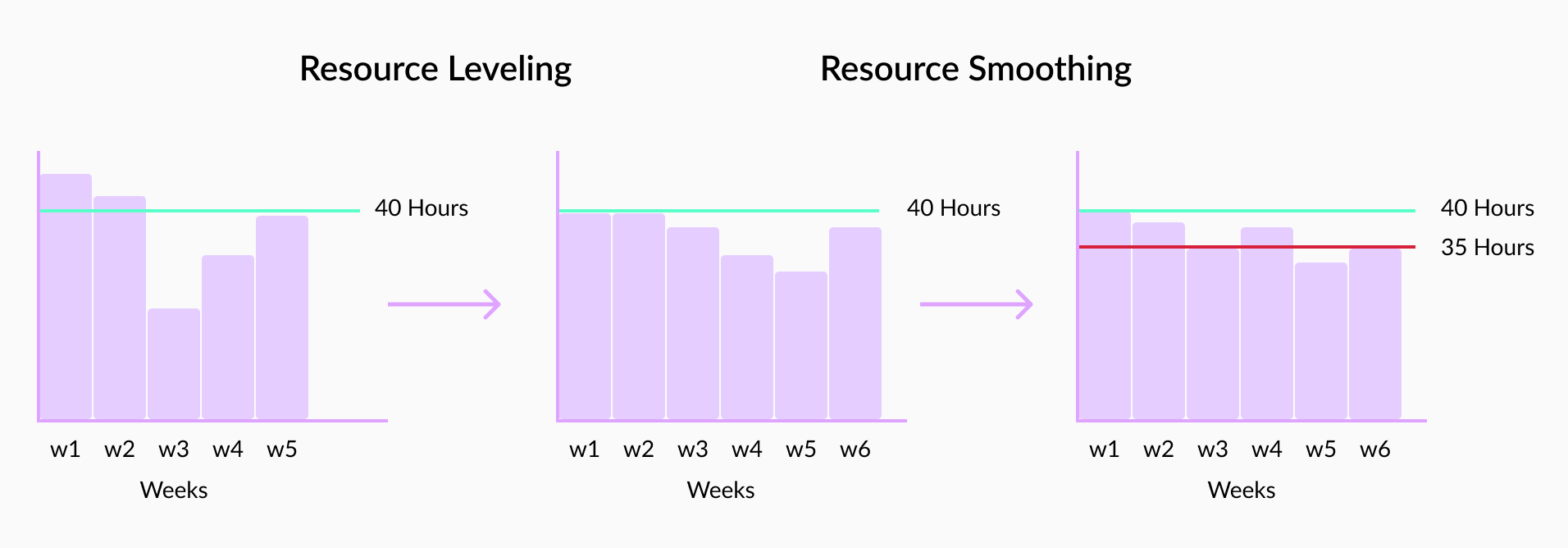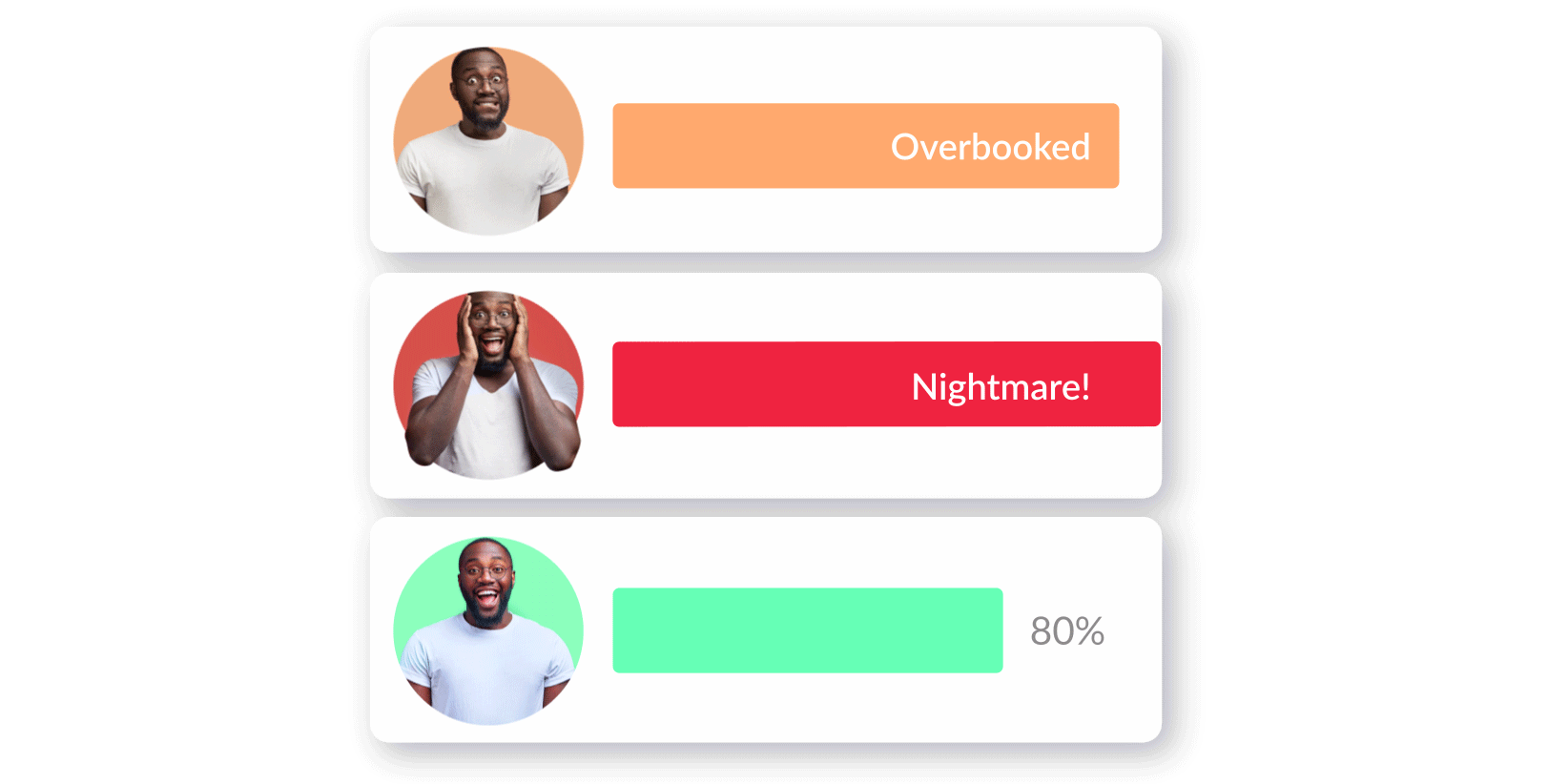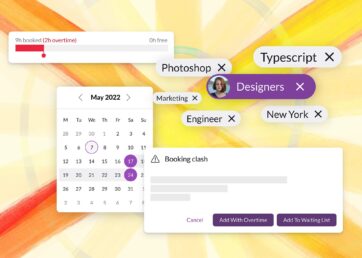You’ve probably heard plenty of ‘best practice’ advice on the steps involved in creating a resource management plan. But when it comes down to doing it yourself, how often is resource smoothing part of the process?
Resource smoothing is non-negotiable if you want your team to be efficient as well as satisfied. Why? Because it allows you to manage time constraints without over-allocating team members, and without sacrificing productivity, missing deadlines, or producing subpar work because you’re in a hurry.
While many resource management techniques are worth implementing, in our opinion, resource smoothing should always be part of your project strategy.
In this article 📖
What is resource smoothing?
Resource smoothing is a project management technique of identifying a project’s critical tasks, then fitting those tasks to a finite timeline.
For example, let’s say you have a project with five steps. Those steps can only be completed in a minimum of four days, but your client needs the project done in three.
You could resource smooth the tasks by identifying the most important steps and deprioritizing the others. You have fewer tasks to complete because you’re only prioritizing the critical steps, so you can actually complete the project in three days and meet your deadline.
Resource smoothing is different from resource leveling, although they’re often compared. At Resource Guru, we advocate for combining these two resource optimization techniques rather than choosing between them.
Resource smoothing vs. resource leveling
If resource leveling is resource availability-focused, resource smoothing is time and resource limitation-focused.
By combining resource leveling and resource smoothing, you’re able to meet your deadlines without peaks and troughs in your resource availability (smoothing) while ensuring that you get the most out of using the tools, employees, and materials available to you without spreading them too thin (leveling).
When you use a time constraint-focused technique, you’re able to reign your project plan in to match the time period you need it to fit.
Once you’ve implemented the resource leveling and made sure your available resources are adequate, you look more closely at whether the work can be completed by the project end date.
If it can’t, or if you need buffer time to prevent burnout on your team, you’d look at the project schedule holistically and decide which actions are part of the path to completion. Managing your tasks in relation to importance and completion date is known as smoothing.

A productivity and burnout prevention strategy
Research published in the International Journal of Environmental Research and Public Health tells us that burnout hinders productivity. Resource smoothing helps your team fight burnout by allowing more buffer time, appropriate resource allocation, better work-life balance, and adequate rest.
When your allocation of resources (people) is aligned with their personal and health needs and provides them satisfaction on a daily basis, your team is able to be productive for the entire span of a project.
Resource smoothing—because it prevents overallocation—also prevents burnout, which leads to longer periods of productivity for your team.
Research from The Hartford on the impact of burnout among U.S. workers notes:
Most respondents (63%) said their overall health/wellness impacts their productivity at work. 30% noted they’re less engaged with their work and 25% said they have trouble concentrating or focusing.
Additionally, employees report that taking breaks helps them maintain focus which makes them more productive.
It would make sense that burned-out employees would miss more work and work less effectively, and smoothing can be used as a proactive tool to give employees downtime, fight burnout, and increase productivity. Obviously, a more productive team means more revenue for the company.
However, being ‘more productive’ can mean different things to different people. Let’s explore 3 specific reasons why resource smoothing improves team performance.
1) Eliminate overallocation
Overallocation can cause employee stress, fatigue, and lowered morale due to having too many tasks and not having enough downtime at work to regroup. This can ultimately lead to unhappiness at their job and can impact the team’s ability to meet goals. Research from Zippia notes:
Unhappy employees cost the U.S. at least $550 billion annually.
Overallocation is a problem for your bottom line and it’s also a problem for your team’s ability to meet their project objectives. Using resource smoothing, you would adjust the necessary project steps to reduce the working demand on your team.
When employees have reasonable project schedules and built-in downtime made possible by smoothing, they have more time to rest, and their brains have more time to solve problems in the background. Smoothing also makes it easier for PMs to reassign work because employees have buffer time built into their schedules.
With resource smoothing, you adjust your project duration to focus on the most necessary steps. This helps you avoid overallocation and lessen the working demand on your team.
Reasonable allocation of limited resources promotes a work environment in which employees are less stressed and therefore more effective at solving problems. In the end, the project gets done, and your team avoids overallocation and the resulting burnout.

2) Meet deadlines more easily
While resource leveling is a great way to tackle overallocation, it often extends the length of your project to prevent task overlap and accommodate task dependencies.
Resource smoothing, on the other hand, prompts you to identify the necessary tasks and cut out the tasks that aren’t crucial, allowing you to meet your deadline without peaks and troughs in your available resources.
When you combine resource smoothing with resource leveling, you’re matching resource availability with the appropriate completion date.
By implementing a time-constraint-focused technique and keeping overallocation in mind, you spread available resources out to avoid extreme changes in resource availability during the project time period, which helps your team finish strong.
Let’s look at an example:
Planning a project that needs to be completed in two weeks with the help of two people is one common scenario.
But if, let’s say, one of those employees is already overloaded and the other is going on vacation during the second week, this scenario becomes a much more complex planning problem.
How do you salvage the project with these allocation and resource constraint issues?
If you resource smooth by condensing the project down to just the essential tasks, you’ll lessen the time needed to complete the project. By reallocating your resources so that demand is more even across your team, you address the employee overallocation problem.
Now, you can meet your deadline because you alleviated the need for two employees on the project. Resource smoothing helped you avoid the inevitable employee burnout that comes through overallocation and constraint issues.
This example of resource smoothing shows how resource optimization techniques can be a powerful part of your team’s project planning process. This approach helps you put less demand on individuals so that you can easily meet your deadline.
Resource smoothing is often brought in as a last resort to fast-track a project when an end date needs to be met, but if you implement it proactively, you can meet more of your completion dates easily instead of scrambling at the last minute.
When you meet deadlines on time, the benefits are obvious. Your company spends less time and money on each project (the team doesn’t have to backtrack and clock more time), customers are happy because they receive their deliverables on time, and employees enjoy the satisfaction of finishing projects on time.


“Resource Guru is simple to use. It allows us to optimize our resources and keeps an eye on every project.”
3) Create buffer time to produce quality work
Resource smoothing helps raise the quality of your team’s work by providing adequate time to complete projects while ensuring that available resources are allocated properly up to the finish date. When you implement smoothing, employees don’t have to rush through projects to get everything done (which can impact their quality of work).
Consider whether a time-focused approach like smoothing could help your team set better quality goals.
If your team is often running behind or struggles to produce because they’re always so busy, smoothing may help your team gain a new perspective on project scheduling, which improves working conditions, reduces stress, and provides breathing room to achieve higher quality deliverables.
How Resource Guru helps you implement resource smoothing
Resource smoothing is a useful technique to keep in your skillset, but you may find it hard to implement with only manual tools.
You can’t eliminate overallocation with standard project management tools like Excel, task-based scheduling software, or by using leveling techniques alone. Those tools don’t take employee capacity into account, which is the basis of resource demand decisions and resource smoothing. Resource management software can simplify this process for your team.
Resource Guru gives you a complete view of capacity across the scope of the project planning process, so you can make quick decisions about work assignments, additional resources, and necessary or unnecessary tasks.
You can also see real-time team resource availability, track down in-demand skillsets, and stay informed of conflicting project commitments. As you implement resource leveling and smoothing, you’re able to check the effect of your changes to make sure your team has a balanced workload and isn’t overallocated.
Try Resource Guru free for 30 days and see how it can help you make resource smoothing an integral part of your project planning process.






